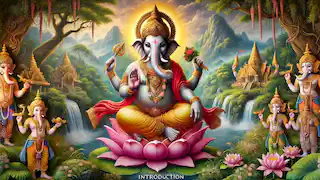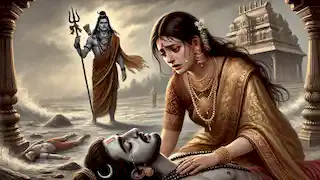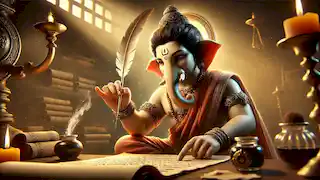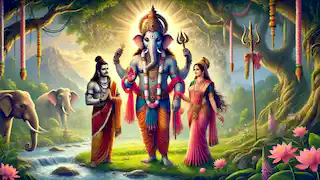The Legend of Ganesha and the Broken Tusk
Reading Time: 6 min

About Story: The Legend of Ganesha and the Broken Tusk is a Myth from india set in the Ancient. This Descriptive tale explores themes of Wisdom and is suitable for All Ages. It offers Cultural insights. The epic tale of Ganesha’s sacrifice and wisdom through the story of his broken tusk.
Introduction
In the vast expanse of Indian mythology, few gods are as beloved or as revered as Lord Ganesha, the elephant-headed deity known for his wisdom, intellect, and charm. He is the remover of obstacles, the patron of arts and sciences, and the god of new beginnings. Yet, there is one particular tale that stands out in Ganesha’s legendary life—the story of how he came to break his tusk. This tale is a profound narrative of duty, sacrifice, and the eternal struggle between wisdom and emotion, making it one of the most treasured stories in Indian folklore.
Birth of a God
Ganesha’s origins are as mysterious and divine as the powers he wields. It is said that Parvati, wife of Lord Shiva, desired a son of her own. Shiva, often engaged in meditation and cosmic duties, spent long stretches of time away from their abode on Mount Kailash. Loneliness filled Parvati’s heart, and thus she took matters into her own hands.
One day, while Shiva was away, Parvati gathered sandalwood paste from her bath and molded it into the form of a boy. She breathed life into the figure, and from her love and power, Ganesha was born. He was perfect in every way—a beautiful child, obedient and strong, with a bright face and a hearty laugh.
Parvati’s love for her new son was boundless. She assigned him a sacred task: to guard the entrance of her quarters while she bathed. Ganesha took his role seriously, standing tall, even as his young heart swelled with pride at the responsibility his mother had given him.

The Great Confrontation
As fate would have it, Lord Shiva returned from his meditation shortly after Ganesha was placed on guard duty. Unaware of the boy's identity, Shiva was astonished to find someone blocking his path to his own home. Ganesha, not knowing Shiva as his father, stood firm in his duty.
“I cannot allow you to pass,” the boy declared, his voice unwavering.
Shiva’s brow furrowed. Who dared defy him? “Do you know who I am, child?” Shiva’s voice thundered, though tempered with curiosity.
Ganesha, holding his ground, responded, “I do not know, nor does it matter. My mother has given me this task, and I must not fail.”
Angered by the boy's disobedience and perceiving it as insolence, Shiva raised his powerful trident. “Step aside, or face the consequences!”
The two clashed in a fierce battle, and though Ganesha was a child, his divine origins gave him great strength. Shiva, one of the most powerful gods in the universe, found himself at odds with this mysterious boy.

The Price of Duty
Hearing the commotion outside her chambers, Parvati rushed out, but she arrived too late. In a fit of divine fury, Shiva had struck Ganesha down with his trident, severing the boy’s head. As his lifeless body fell to the ground, Parvati’s wails of grief shook the heavens.
“How could you?” she cried, her voice filled with anguish. “He was our son!”
Shiva, now aware of the terrible mistake he had made, was filled with regret. He could not undo his actions, but he vowed to make amends. Desperate to restore life to his son, he instructed his followers to bring him the head of the first creature they encountered. The first living being they found was an elephant, and thus, with its head, Ganesha was revived.
Though Ganesha now bore the head of an elephant, his mother’s love for him did not diminish. He was unique, a god born of both divine will and maternal affection, and his new form symbolized wisdom, strength, and patience.
The Sage Vyasa’s Request
Years passed, and Ganesha’s fame spread throughout the cosmos. His wisdom and intelligence became legendary, and it was said that no task was too difficult for him to accomplish. One day, the great sage Vyasa, who had been composing the epic Mahabharata, sought out Ganesha’s help.
The Mahabharata was an epic unlike any other—a story so vast, so intricate, that Vyasa knew he needed a scribe of unparalleled wisdom to help him pen it. Ganesha, with his brilliant mind and unmatched focus, was the perfect choice.
When Vyasa approached him, Ganesha agreed to help but imposed a condition: Vyasa would have to recite the poem without pausing, and Ganesha would only write as long as the sage’s words flowed without interruption.
Vyasa, sensing the challenge, agreed but also devised a plan. He would occasionally throw in complex verses to slow Ganesha down, giving himself time to think.

The Breaking of the Tusk
As Vyasa began reciting the Mahabharata, Ganesha wrote with extraordinary speed. The sage’s words poured forth like a river, and Ganesha’s quill danced across the page. But soon, the quill began to wear down under the intensity of the task. The more he wrote, the faster the quill broke, until finally, it snapped in two.
Faced with a dilemma, Ganesha, ever resourceful, decided to break off his own tusk and use it as a pen. Without hesitation, he snapped his right tusk and dipped it into the ink, continuing to write.
This act of sacrifice became one of Ganesha’s defining moments, symbolizing his commitment to duty, even at the cost of personal suffering. From that day onward, Ganesha would be depicted with a broken tusk, a reminder of the lengths he was willing to go to ensure the success of a noble endeavor.
The Wisdom of the Broken Tusk
Ganesha’s sacrifice earned him even greater reverence among gods and mortals alike. He became the embodiment of wisdom, duty, and selflessness. The broken tusk, once a sign of imperfection, became a symbol of strength.
The Mahabharata, completed with Ganesha’s help, became one of the greatest epics ever told, a story of war, love, duty, and morality. And Ganesha’s role in its creation ensured his place in the hearts of people for generations to come.

Legacy of the Elephant-Headed God
To this day, Ganesha is invoked at the start of every new endeavor. His image, with the broken tusk and elephant head, reminds us that true strength lies not in physical perfection but in the wisdom to overcome obstacles, the dedication to one’s duty, and the willingness to make sacrifices for the greater good.
In homes, temples, and festivals across India, people worship Ganesha with great devotion. The story of his broken tusk serves as a powerful reminder of the importance of perseverance, intelligence, and humility. Ganesha, the remover of obstacles, continues to inspire and guide those who seek his blessings.
Conclusion
The legend of Ganesha and his broken tusk is a timeless tale of sacrifice and wisdom. It reminds us that even gods must endure hardship and that the greatest victories often come with personal loss. Ganesha’s broken tusk is not a flaw but a testament to his greatness, a reminder that no obstacle is too large when one’s heart is full of devotion and purpose.
His story continues to echo through the ages, and in every household where his name is spoken, Ganesha stands as the eternal protector, the wise guardian of beginnings, and the harbinger of success.

















